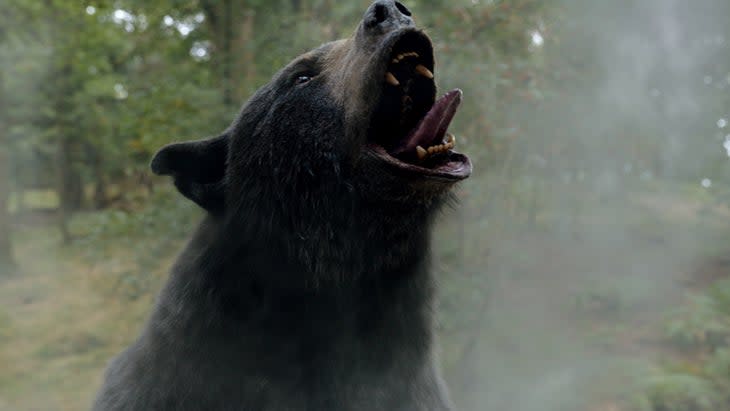How Accurate Is ‘Cocaine Bear’? We Went to See it.
- Oops!Something went wrong.Please try again later.
- Oops!Something went wrong.Please try again later.
This article originally appeared on Backpacker
If you watched the trailer for Cocaine Bear, you knew by the time you sat down in the theater that the movie’s going to be pretty campy. The trailer opens on a bloodied, lifeless body acting as a doorstop as a pair of EMTs try to enter a cabin; soon after, a drooling black bear tackles one of them, pausing its rampage just long enough to let loose a murderous roar.
The rest of the movie follows that tone. Although it's loosely inspired by the real-life story of the 175-pound black bear that found the duffel bags of cocaine that drug smuggler Andrew C. Thornton II dropped from a too-heavy plane into the Chattahoochee-Oconee National Forest in 1985, Cocaine Bear takes plenty of artistic license. Some deviations from reality were for humor; some were for drama. But, even though this movie passes the Bechdel Test, it doesn't pass the Dangerous Bear Trope Test.
Cocaine Bear is the latest in a long line of movies to portray bears as bloodthirsty beasts, clamoring for the chance to feast on innocent humans. The movie's total kill count of 11 (some at the hands of humans, some at the paws of the bear) and disembodied limb count of 4 2/5 --four limbs and two fingers--are a big stretch from the real bruin's kill count: zero, unless you count the bear itself.
Admittedly, there isn't a lot of peer-reviewed research about what blow does to bears. Nobody actually knows what went down when the bear (dubbed Pablo Escobear, obviously) got a noseful of coke. We only saw the aftermath of its fatal overdose: Investigators found that the real Cocaine Bear didn't even eat all 75 pounds of blow that landed in the forest. It had just enough that by the time the Georgia Bureau of Investigation investigated the bear's dead body, its stomach was packed to the brim with the drug, but authorities say it had only 3 to 4 grams of it in its bloodstream at the time of its death.
That, of course, is too tame for Hollywood. Media has its fair share of cuddly bears (Winnie the Pooh's only vice is honey, the Berenstain Bears would warmly offer life lessons in conflict, and Paddington's too polite to maul anyone to death). But for the most part, movies show bears as fanged brutes ready to make a meal of any hiker they come across. More than anything else, they're devices used to make a bad situation worse.
That's how the plot of Cocaine Bear hooks you: Young hikers find the cocaine and naively eat tablespoons of it, drug runners scavenge for their millions of dollars of lost revenue, and nefarious teens try to smuggle some nose candy for themselves. Meanwhile, there's an on- and off-camera cocaine-hungry bruin that could be anywhere in the forest, hunting down packages of powder, stopping at nobody or nothing to chase that high.

In the real world, bears don't want to be bothered, and if they see humans, they'll likely just move away. But step into the cinematic world of Cocaine Bear, Into the Grizzly Maze, or The Edge the question isn't "if" you'll meet a bloody end, it's "when." We reduce ursines to convenient scapegoats for our own fears--of the wilderness, of our own vulnerability. But that's not fair, especially to the relatively small, timid black bears that live in Georgia.
Not everything about Cocaine Bear is made up. As two unfortunates discover, bears, especially black bears, are expert tree climbers, capable of ascending about 20 meters in just 8 seconds. They can run really fast (at a top speed of 35 mph, Pablo Escobear could match an ambulance for a couple seconds before it eventually accelerates out of danger). They'd rather eat whatever is available, such as human food or smellables, than hunt for it themselves. They also love a good scritch and will happily use a tree trunk or the ground as a back scratcher.
But as far as accuracy goes, that's about it--from there, most of Cocaine Bear was a Hollywood daydream. The solid majority of the 95-minute movie is Final Destination-level gore and suspense.
That doesn't seem to have been an accident: In an interview with Variety, director Elizabeth Banks said that she felt a "deep sympathy for the [real] bear" knowing that it got caught up in a bad drug situation, and "this movie could be seen as the bear's revenge story."
Historically accurate or not, audiences have flocked to see Cocaine Bear: The movie ended its opening weekend with $23.1 million, higher than most industry watchers expected. The movie's campiness has spawned a legion Twitter memes, which is basically the cultural litmus test for what's hot. It's a movie that people love to hate (a la Godzilla, Jaws, or The Room). After leaving the theater, I was recalling the plot to a friend over lunch when a woman stopped at our table and said, "Don't see that movie. It was a waste of my money, way too over-the-top." Laughing, I told her that she was right, but that was the best part. If you can get over the CGI, gallons of fake blood, and a bear that only has a passing resemblance to the real thing, Cocaine Bear is one ferocious ride.
For exclusive access to all of our fitness, gear, adventure, and travel stories, plus discounts on trips, events, and gear, sign up for Outside+ today.

